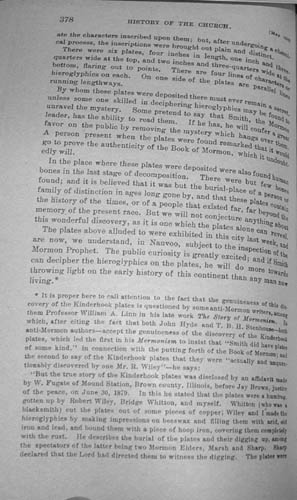Kinderhook plates: Image 7 of 8
![[First]](bw_first.gif)
|
![[Prev]](bw_prev.gif)
|
![[Index]](bw_index.gif)
|
![[Next]](bw_next.gif)
|
![[Last]](bw_last.gif) |
 |
Joseph Smith, History of the Church, Vol. 5, Ch. 9, p.378 obliterate the characters inscribed upon them; but, after undergoing a chemical process, the inscriptions were brought out plain and distinct. There were six plates, four inches in length. one inch and three-quarters wide at the top, and two inches and three-quarters wide at the bottom, flaring out to points. There are four lines of characters or hieroglyphics on each. On one side of the plates are parallel lines running lengthways. By whom these plates were deposited there must ever remain a secret, unless some one skilled in deciphering hieroglyphics may be found to unravel the mystery. Some pretend to say that Smith, the Mormon leader, has the ability to read them. If he has, he will confer a great favor on the public by removing the mystery which hangs over them. A person present when the plates were found remarked that it would go to prove the authenticity of the Book of Mormon, which it undoubtedly will. In the place where these plates were deposited were also found human bones in the last stage of decomposition. There were but few bones found; and it is believed that it was but the burial-place of a person or family of distinction in ages long gone by, and that these plates contain the history of the times, or of a people that existed far, far beyond the memory of the present race. But we will not conjecture anything about this wonderful discovery, as it is one which the plates alone can reveal. The plates above alluded to were exhibited in this city last week, and are now, we understand, in Nauvoo, subject to the inspection of the Mormon Prophet. The public curiosity is greatly excited; and if Smith can decipher the hieroglyphics on the plates, he will do more towards throwing light on the early history of this continent than any man now living.* * It is proper here to call attention to the fact that the genuineness of this discovery of the Kinderhook plates is questioned by some anti-Mormon writers, among them Professor William A. Linn in his late work The Story of Mormonism. In which, after citing the fact that both John Hyde and T. B. H. Stenhouse—both anti-Mormon authors—accept the genuineness of the discovery of the Kinderhook plates, which led the first in his Mormonism to insist that "Smith did have plates of some kind," in connection with the putting forth of the Book of Mormon; and the second to say of the Kinderhook plates that they were "actually and unquestionably discovered by one Mr. R. Wiley"—he says: "But the true story of the Kinderhook plates was disclosed by an affidavit made by W. Fugate of Mound Station, Brown county, Illinois, before Jay Brown, justice of the peace, on June 30, 1879. In this he stated that the plates were a humbug, gotten up by Robert Wiley, Bridge Whitton, and myself. Whitton (who was a blacksmith) cut the plates out of some pieces of copper; Wiley and I made the hieroglyphics by making impressions on beeswax and filling them with acid, old iron and lead, and bound them with a piece of hoop iron, covering them completely with the rust. He describes the burial of the plates and their digging up, among the spectators of the latter being two Mormon Elders, Marsh and Sharp. Sharp declared that the Lord had directed them to witness the digging. The plates were |